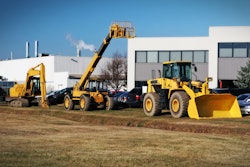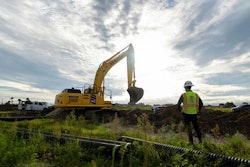
The construction industry has seen a new wave of volatility and uncertainty to kick off 2025, giving renewed importance to keeping track of the industry’s stats and benchmarks.
A recent webinar hosted by information and tech provider ConstructConnect covered key economic trends that contractors should be watching throughout 2025.
1. Nonresidential Construction Job Gains Remain Strong
Though the rate of job gains in nonresidential construction has slowed from the relative highs of 2022 and 2023, it continues to outpace growth in other sectors.
 Bureau of Labor Statistics
Bureau of Labor Statistics
Ken Simonson, chief economist at the Associated General Contractors of America, said during the webinar that the most recent data from the Bureau of Labor Statistics shows total construction employment was up 1.7% year-over-year in April, which added about 150,000 jobs.
Nonresidential construction jobs rose 2.9% in the same period. The industry saw only a 0.1% year-over-year increase in residential construction jobs last month.
States with the most construction employment gains between March 2024 and March 2025 were:
- New Mexico: +12.0%
- Idaho: +10.0%
- Kentucky: +8.0%
- Ohio: +6.7%
- South Carolina: +6.7%
States with the greatest year-over-year declines in construction employment were:
- Washington: –5.3%
- Iowa: –4.8%
- Massachusetts: –4.1%
- Montana: –4.0%
- Arizona: –2.8%
2. Construction Job Openings & Layoffs are Trending Down
Simonson also points to BLS data when showing that construction job openings and layoffs as a percentage of the total workforce have trended down in the last year.
In March of this year, layoffs represented just 1.7% of the total workforce, compared to 2.2% in March 2024 and 8.5% in March 2020. Similarly, job openings made up 2.9% of the total workforce, down from 4.0% in March 2024.
 Bureau of Labor Statistics
Bureau of Labor Statistics
Construction job hires as a percentage of total employment came in at 3.6% this March vs. 4.1% in March 2024.
“Job openings as a percent of filled and open jobs have also been tailing off quite sharply over the last three years, including the last year. Openings advertised at the end of March were only 2.9% of the workforce,” said Simonson. “And while that's not a record low, it clearly shows that firms not only are not hiring now, they're not even looking to hire at the extent that they had been. So that suggests that there's a big pause going on in current construction.
“But there's one other thing to note, layoffs also have dropped to a near to a record low for March. And so that says to me that while firms aren't busy enough right now to be hiring or advertising jobs, they still expect to pick up in the near future, and that's why they're hanging on to the workers.”
3. Wages Down Slightly, But Construction “Premiums” are Rising
Average hourly earnings for construction workers rose 3.9% year-over-year in March 2025 and are up 25% from February 2020, according to BLS data. However, the most recent 3.9% increase is down from a roughly 5% year-over-year increase that remained steady from February 2022 until September 2024.
 Bureau of Labor Statistics
Bureau of Labor Statistics
Union and salaried wages in the industry also remain on the upswing, said Simonson.
“AGC is one of about 10 associations that support the Construction Labor Research Council, which analyzes all union settlements, and they reported that last year that first-year settlements averaged 4.7%,” said Simonson. “In fact, 15% of settlements had a first-year increase of more than 6.5%, and so that suggests that the floor has been built in, at least for union wages.
“Another source, PAS, that has for over 40 years surveyed companies in construction about what they pay their salaried and executive employees, also found that wages were going up, or salaries going up at about a 4.5% rate last year.”
Another trend worth watching, according to Simonson, is the rising “premium” contractors are paying their workers, meaning how much more workers are paid to stay in construction vs. working in other fields.
Overall, the construction wage “premium” was +18.8% in March 2025 vs. +16.6% in January 2022. For nonresidential building construction, the premium sat at 27.3% as of March, up from 26.9% in January 2022.
4. Material Costs Remain Volatile
While the money going to those working on construction has remained relatively steady in the last few years, material input prices are another story. Simonson points to the producer price index for nonresidential inputs, which recently rose to 1.1% as of March 2025. While this pales in comparison to the 40% increase the industry saw in February 2020, the latest 1.1% is the largest year-over-year increase this industry has seen since July 2024.
“Input costs for construction have gone up 40%, much more than the 24% that consumers have rightly complained about,” Simonson said. “In fact, for some materials, it's much more. Copper and brass mill shapes, that price has gone up 69%. For steel mill products, 54%, and for gypsum building materials, 52%. And these are based on prices that were collected around March 11, before the tariffs have taken effect.”














